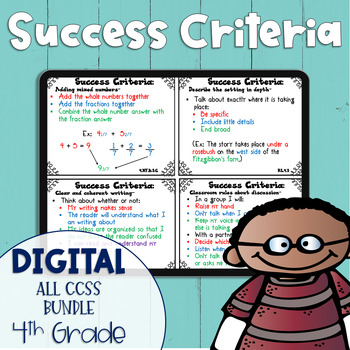DIGITAL Success Criteria for Common Core Learning Targets All Subject BUNDLE

Description
Learning targets are an amazing way to help your students take ownership in their own learning process. But then what? Show your students exactly HOW they will be successful at meeting their daily, weekly or unit long objectives. Each of these ready to go success criteria are aligned to the Math, Reading, Writing, Speaking & Listening and Science Next Generation and Common Core State Standards for fourth grade. They explicitly tell and/or show your students different ways to be successful in meeting their learning targets. They come in both color and black and white, so you can choose what works best for you. They help your students understand each step in the process of meeting the specific standard they are working on.
They're Digital
Are you doing distance learning or a hybrid this year? This is a DIGITAL (Google Slides) version of the original paper version seen here:
Success Criteria for Common Core Learning Targets Bundle; 4th Grade
**This resource comes as a link in a PDF file. Click on the link and you will be prompted to 'Make a copy'. Directions on how to get started are included in the PDF.
They're Convenient
The standard is written in the lower right corner, so it’s quick and easy to find your success criteria in seconds. No more spending tons of time trying to come up with what the success criteria will be or having to do it on the fly with your students. Now you can spend your time planning the actual instruction!
They're Versatile
♦ Post them on your digital platform next to your learning targets, standards or objectives
♦ Use it as a guide as you type them with your students
They're Editable
They come with an editable template, so you can add or change the wording on any success criteria to meet the needs of your students or teaching style.
Click below to see the individual sets:
Digital Math Success Criteria; 4th Grade
Digital Reading Success Criteria; 4th Grade
Digital Writing Success Criteria; 4th Grade
Digital Speaking & Listening Success Criteria; 4th Grade
Digital Science Success Criteria; 4th Grade
You may also be interested in the learning targets:
Digital Math Learning Targets; 4th Grade
Digital Reading Learning Targets; 4th Grade
Digital Writing Learning Targets; 4th Grade
Digital Speaking and Listening Learning Targets; 4th Grade
Digital Science Learning Targets; 4th Grade
Digital Learning Target Bundle; 4th Grade
Or the MEGA Bundle:
Digital Learning Target & Success Criteria MEGA Bundle; 4th Grade
CLICK HERE to Follow Me and be the first to hear about my newest products, freebies and sales!





